
I left Antigua on September 12 for Panajachel on Lago de Atitlan, the Lake Atitlan in the news in October 2005 following the flooding and mud slides caused by Hurricane Stan. I took the local buses, sometimes called chicken buses, which are old U.S. school buses and usually packed beyond belief. They are cheap and go everywhere, but tough to take for long rides. I got a 100 Quetzal room, about $12.50, in the Posada Monte Rosa in Panajachel. Panajachel is an interesting town. It used to be a hippy hang-out, but I think a lot of the hippies have returned to the U.S. to open "international" stores that mostly sell crafts and clothes from Guatemala. Now the town has a hippy/Mayan flea market feel to it.
Lago de Atitlan is more impressive; it is a lake covering about fifty square miles in a caldera left by a massive volcano. The lake is ringed by mountains and three volcanoes and no rivers flow in or out of the lake. The water level of the lake can change significantly over time, and I don't think the hydrodynamics are understood. Rain that falls on the surrounding hills, which have a number of villages and a lot of land being farmed, drains into the lake, which is the only source of water for the villages. In other words, all the waste from the surrounding communities washes into the only water supply. One night I watched people set up the pumps and hoses that take water from just a few yards off shore into the tanks which provide water for the surrounding hotels and restaurants. The warning "don't drink the water" is especially applicable in this area. I had only drunk bottled water since arriving in Central America, once I realized what was coming out of the faucets around Atitlan I started brushing my teeth with bottled water. But the setting is beautiful. A few composites of Lago de Atitlan and two of the volcanos bordering it:


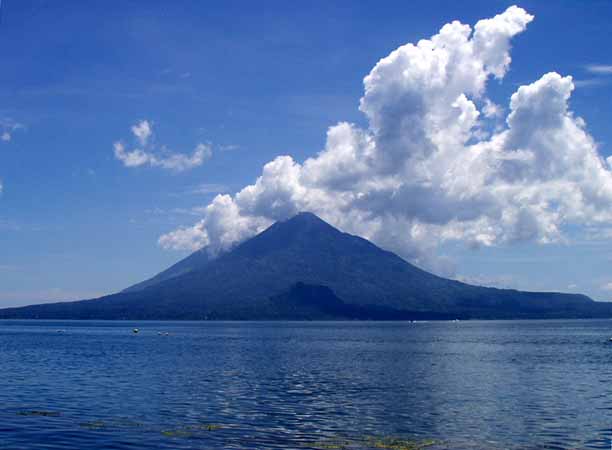
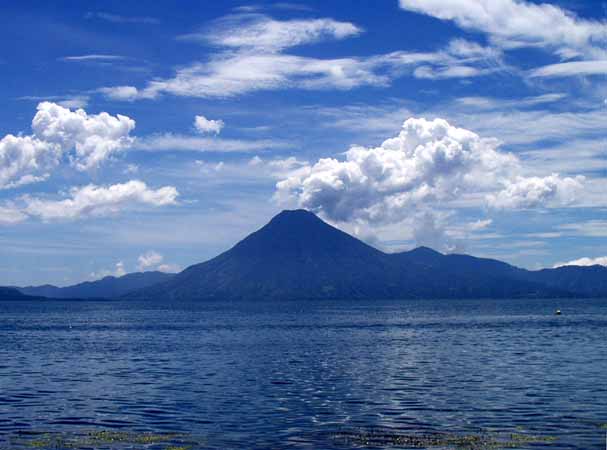
On Monday, September 15, I walked from Panajachel to the nearby village of Santa Catarina Palopa. Santa Catarina has a number of weaving shops that depend on tourist money, but the town is not nearly as touristy as Panajachel. I took a picture of the village from a high spot on the walk over, and, after buying some cloth and asking permission, I took a picture of one of the Mayan women making a traditional pattern cloth with a backstrap loom:

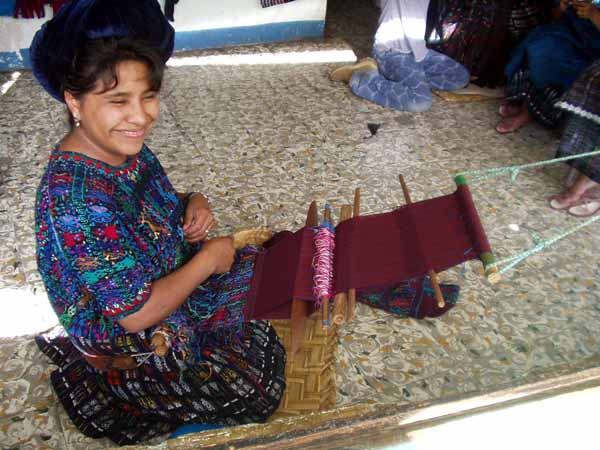
Panajachel also has lots of Mayan vendors, all women or children, prowling the main drag. I bought some souvenirs from them, always with the condition that I be allowed to take a picture. I had been cautioned against taking pictures of the Maya without permission; they sometimes get really angry about this. Almost all Guatemalans in this part of the country are Mayan. In fact in many parts of Guatemala and southern Mexico many people speak one of several indigenous languages as their first language and Spanish as their second. Many of the women wear traditional dress, the men almost all wear modern clothing. The men weren't nearly as photogenic.

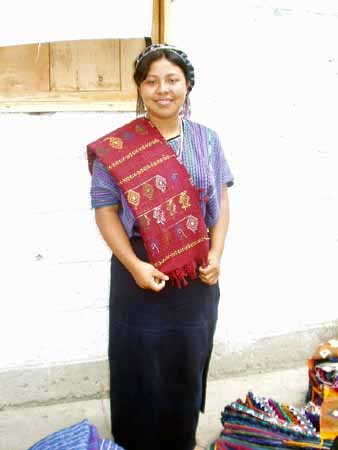

On September 17 I mailed a large bundle of souvenirs/oddball Christmas gifts to the U.S. and on September 18 I took a boat across Lake Atitlan to San Pedro La Sula. Panajachel is a good place for souvenir shopping and has modern conveniences like international shipping and ATM's, but a few days there is enough.
This is what San Pedro La Laguna looks like when you first arrive; a small dock at the start of a steep street leading into town. The first building is Nick's Place, which is a late night restaurant of last resort. Just above Nick's place is D'Noz, and above D'Noz is Alegre Pub. More on them later. The second picture is from a short distance up the same street looking back at the lake. The stairs on the side of the corner building lead to Alegre Pub.
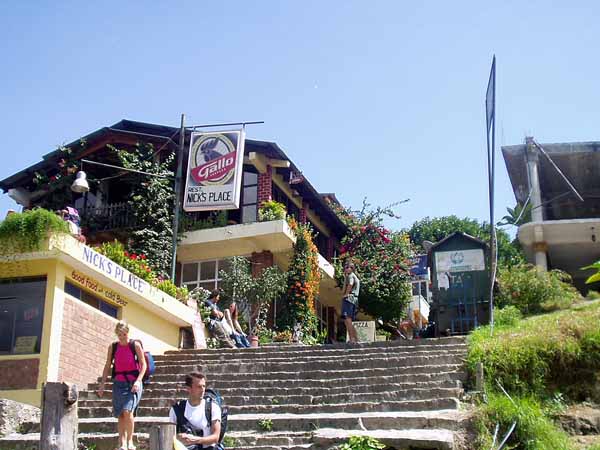
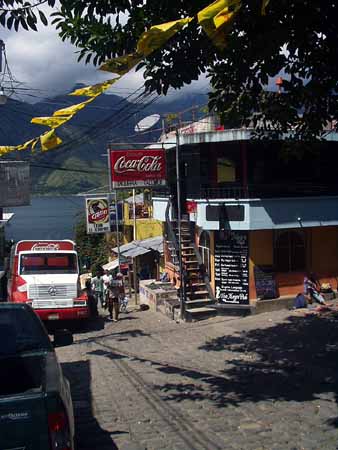
San Pedro is not exactly an undiscovered Mayan village, it has a strong ex-pat and backpacker presence there. But it is a laid back place with nice views, scenic walks, good bars and restaurants and several Spanish schools. The ex-pats are mostly Europeans who run a number of restaurant/bars, the backpackers included a large Israeli contingent, who are good at locating low-cost, high-pot places. Many young Israelis go on a globe hopping backpacking tour after finishing their military commitment and cluster in inexpensive areas with recreational drugs. In the U.S. people usually get that out of their system in college, maybe that is not possible in Israel. There were also European backpackers and Kate and Jane, two Arkansas college students who were supposedly in Guatemala doing research, but mostly seemed to be enjoying themselves while working at D'Noz. I think I was the second oldest gringo in town, the oldest was a Canadian hippy who would walk into bars and loudly ask "Does anyone here want to buy some pot?". He was a permanent resident of San Pedro.
I got a nice room for about $10 a night and stayed until October 24. I took refresher Spanish classes with Brenda, a local teacher. Unfortunately I didn't note her last name or the price for classes, but I'm pretty sure the classes cost 100 Quetzal, about $12.50, for two hours of individual instruction. Ten hours of individual instruction a week for a little over $60 is a bargain, and Brenda was an excellent instructor. She helped me relearn the Spanish I forgot while spending a summer speaking English on Roatan. My grammar and vocabulary improved significantly while taking lessons from her. If you are ever in San Pedro de Sula in need of Spanish instruction I recommend Brenda highly. She's easy to find; she and her husband have a one room school across the street from Cafe Arte.
The first thing I did in San Pedro was catch a cold. Lake Atitlan is high enough for mild weather even though the latitude is tropical, and September is rainy enough so it is impossible to avoid getting drenched. I rested, read, and established a routine that included a great deal of time at D'Noz and Cafe Alegre. D'Noz was run by Dean, a Dutchman who probably could have been making big bucks as a chef in Europe or the U.S., but he liked running his own place in Guatemala. Cafe Alegre was run by an English couple, Matt and Dawn, who served traditional English food, such as curry. D'Noz had the better food and pretty bartenders, but Matt's place was friendlier.
I did meet and talk with some of the local people; the United States is not held in high regard by everyone there. In the 1980's Ronald Reagan reversed Jimmy Carter's policy of making human rights a priority in international relations; Reagan's priority was anti-communism and he backed the military government of General Jose Efrain Rios Montt. There were confrontations over land between the Mayans who had lived on and farmed the land and the government that claimed to own it. The government would sell large parcels of land to businesses and expel the Maya who had lived on it for centuries. The Mayans resisted, the government called them communists (they may have been getting some support from the USSR, I don't know) and, cold war politics being what they were, the U.S. supported a brutal government that massacred thousands in a dirty war. The Lake Atitlan region suffered a great deal during this period and to this day some of the locals refer to the U.S. as "Estados Maldidos".
I only took a few pictures of San Pedro de Laguna during my five weeks there. The first set are of Lake Atitlan seen from San Pedro, the taxi boats, and the rocks where women wash the clothes, not far from where lake water is pumped into tanks for the villages plumbing.


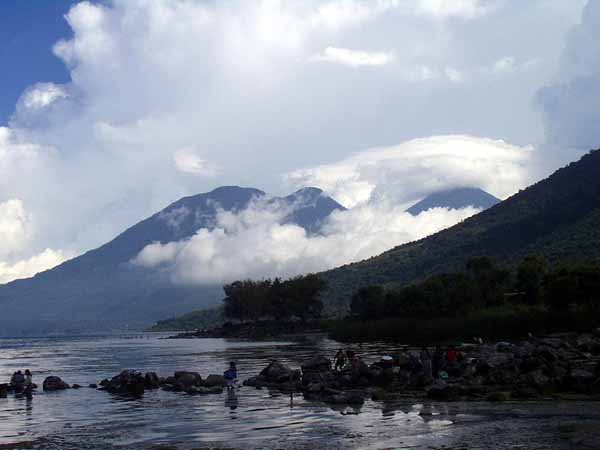
These pictures were taken during a walk part way up a trail leading to a peak called Indian Nose. The first two are of San Pedro as seen from points east, followed by two children who wanted their picture taken, then expected a Quetzal:


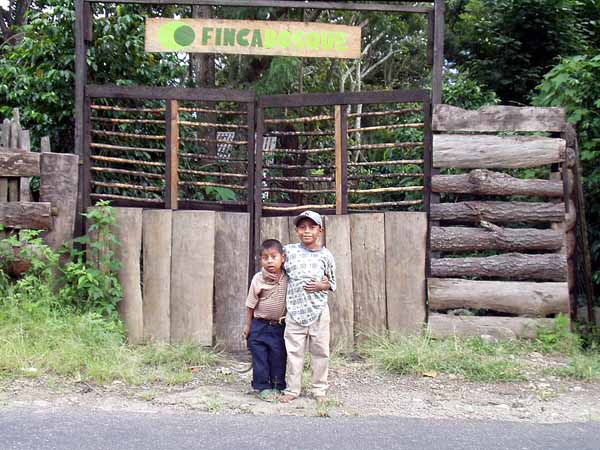
Some shots from further up the Indian Nose hike. Another shot of Lake Atitlan, then a picture with San Pedro in the background and San Juan La Laguna in the foreground, and a another shot of the lake:

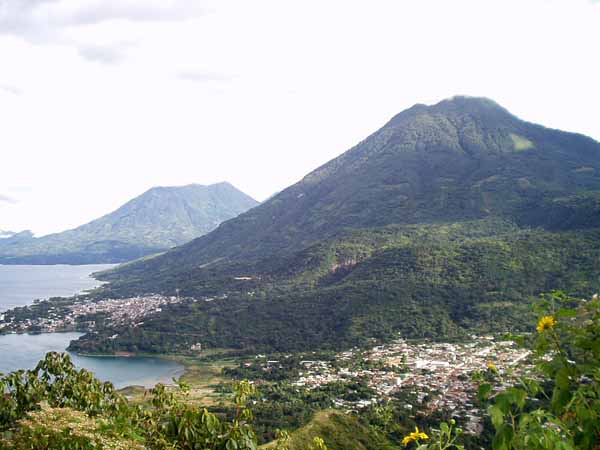
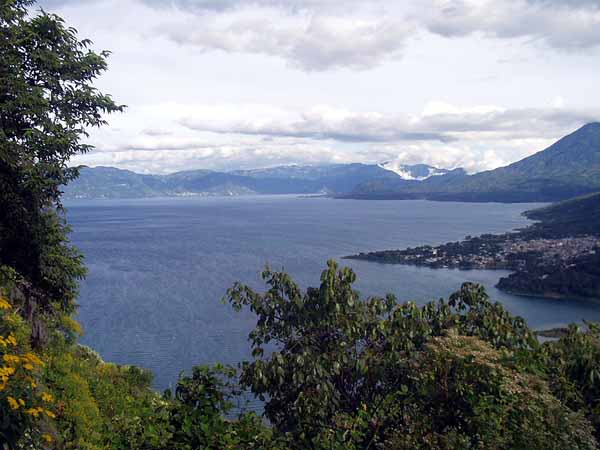
This is my attempt at showing how steep the terrain is that the local people farm. The corn is planted on what looked like a 70 degree incline, and my finger is in the picture because I was more concerned with not falling down this incline than getting the picture perfect. Not only are these fields planted, maintained and harvested by hand, but all tools, seed and the harvest have to be manually packed up and down the steep trail from the village in the background. These Maya farmers are very tough, hard working people:
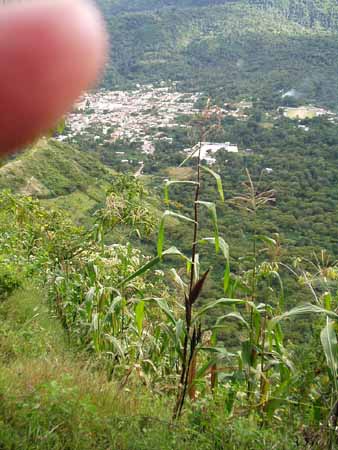
Finally some pictures taken from D'Noz and Alegre Pub. The first picture is of Indian Nose, taken from the deck of D'Noz. The next two pictures are of the interior of D'Noz, in the one with the bar and deck that is Dean the owner/chef in the far right. I returned that evening and got a picture of me and Dana or Donna, I never asked about the spelling, who was one of the bartenders in D'Noz. The final picture is of Klaus and Dana; Klaus is another bartender in D'Noz and is originally from the U.S., though I gather he hasn't spent much time there in the last couple of decades. As you may have noticed, one of the main beers in Guatemala is Gallo, and is available in large bottles:
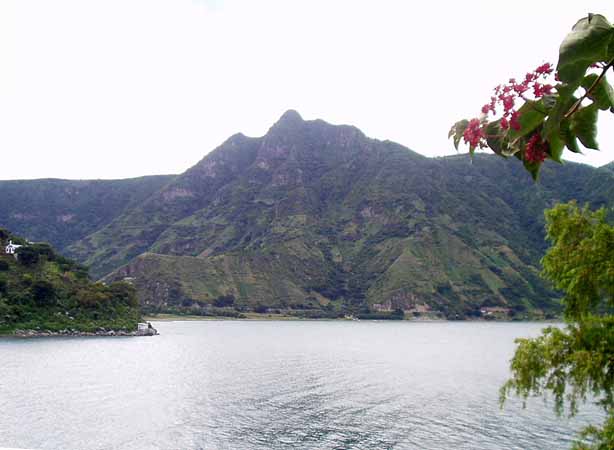

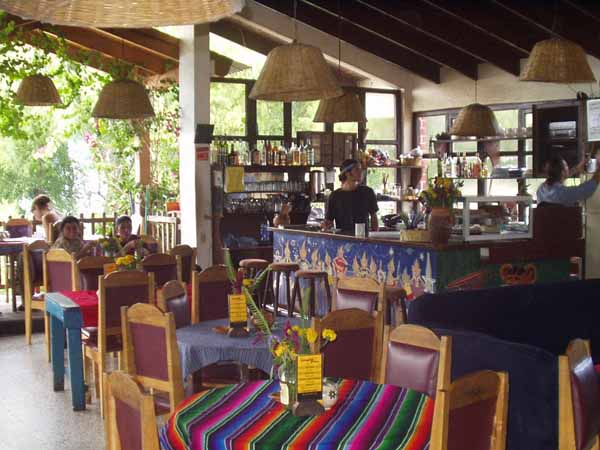
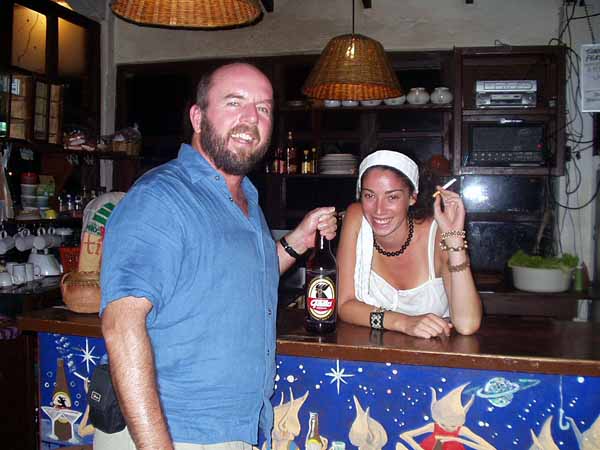

Next is the interior of my other main hangout, Alegre Pub, run by Matt and Dawn. Unfortunately Matt and Dawn weren't there when I took my camera, in fact it was pretty quiet. I need to take better notes, I can't remember the name of these two young women:
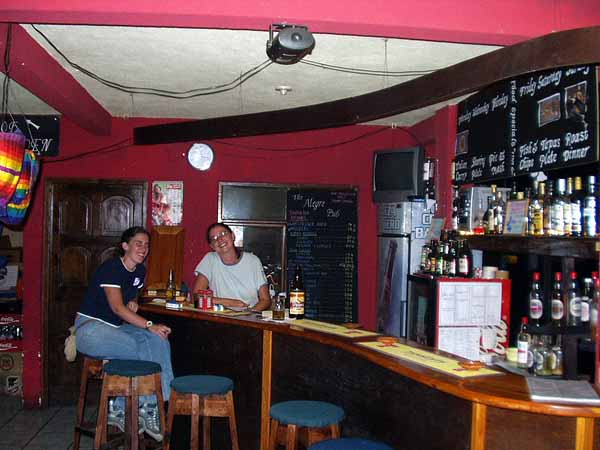
I didn't accomplish much beyond the Spanish classes during my five weeks in San Pedro, but I enjoyed mellowing out there, and I did need the refresher classes. On October 24 I finally got in gear and caught a series of chicken buses for a late arrival back to Antigua. I spent a couple of days checking out travel options to Flores. Early in the morning of October 27 I took a shuttle bus to Guatemala City where I switched to a first class bus (individual cushioned seats and air conditioning, very different from chicken buses) and arrived in Flores early that evening. Flores is the starting point for visiting Tikal.